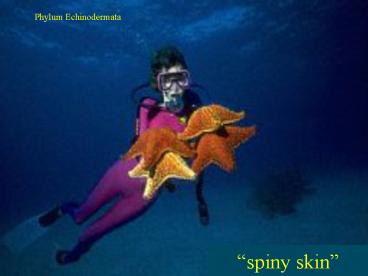Phylum Echinodermata - PowerPoint PPT Presentation
1 / 66
Title:
Phylum Echinodermata
Description:
two body openings ... Most echinoderms use a water vascular system similar to this one. ... no space between rays. space between rays is filled in. ray. sand dollar ... – PowerPoint PPT presentation
Number of Views:207
Avg rating:3.0/5.0
Title: Phylum Echinodermata
1
Phylum Echinodermata
spiny skin
2
Echinoderm
Characteristics
1. radial symmetry
2. endoskeleton
3. spiny skin
4. water vascular system
3
All echinoderms have radial symmetry.
feather star
starfish
brittle star
sand dollar
sea cucumber
4
They start out, however, with bilateral symmetry.
starfish larvae
5
All echinoderms also go through deuterostome
development (this means the blastopore becomes
the anus).
two body openings
Note the mouth is on the ventral (oral) surface
and the anus is on the dorsal (aboral) surface.
This is true for most echinoderms.
6
The skeleton of the echinoderm is internal
because it is covered with skin.
skeletal remains
with skin (alive)
7
Echinoderms are considered to be related to
vertebrates because of these three
characteristics.
1. bilateral larvae
2. deuterostome development
3. internal skeleton
8
Echinoderms have a spiny skin. The spines vary in
length.
very long spines
very short spines
9
Most echinoderms use a water vascular system
similar to this one.
10
Tube Feet - used for movement, respiration and
feeding.
tube feet
11
Close-up of Tube Feet
tube feet
They are on the ventral surface.
12
Echinoderm Classification
Kingdom
Animalia
Phylum
Echinodermata
Class
starfish -
Asteroidea
sea lilies -
Crinoidea
brittle stars -
Ophiuroidea
sea urchins -
Echinoidea
sea cucumbers -
Holothuroidea
13
Class Asteroidea
starfish
aster means star
14
Starfish Characteristics
- most have 5 rays (arms)
- rays are broad at base
- all live in the ocean
15
A Larval Starfish
Even at this stage you can see 5 rays developing.
16
Starfish come in many colors.
17
Starfish are also called sea stars.
18
Starfish usually have 5 arms
called rays.
19
Some have more than 5 rays.
20
For some, the rays are fat or
tissue fills in the space.
21
Starfish have spines.
Some are large, some are small.
22
Starfish eat other animals.
eating a clam
eating coral
spines
eating a
sea urchin
mouth
ventral surface
23
Feeding
Starfish use their tube feet to pry open bivalves
(a favorite food).
stomach
ventral surface
They extend their stomach out their mouth to
digest the bivalve.
24
Starfish have been around
a long time!
25
Although they cant be seen, starfish have
eyespots at the ends of their rays.
26
Starfish Body Structures
anus
stomach
madreporite plate
tube feet
stone canal
ampulla
digestive glands
radial canal
ring canal
27
Class Crinoidea
sea lilies
and
feather stars
28
Crinoid Characteristics
Sea Lilies
- sessile with a stalk
Feather Stars
- swim with feathery rays
29
Many crinoids look like flowers.
30
Sea Lilies
31
stalk
sea lilies have a stalk
32
the stalk makes it look like a lily
33
feather stars have no stalk
34
Feather star on a rock.
35
Red Sea Feather
36
The Pink Feather Star
37
Feather Star with many rays
38
A feather star eating a starfish.
39
more feather stars
40
Class Ophiuroidea
brittle stars
41
Brittle Star
Characteristics
- rays are very thin
- rays are very brittle
- rays used for movement
(not tube feet)
42
long thin rays
43
central disc
anus in middle of disc
44
Black Brittle Star
45
brittle star with long spines
46
more brittle stars
47
Class
Echinoidea
sea urchins
and
sand dollars
48
Sea Urchin
Characteristics
- shaped like a globe
- long, hard spines
49
(No Transcript)
50
sea urchin
51
many spines
sometimes they are poisonous
52
some have small spines
53
more sea urchins
54
Sand Dollar
Characteristics
- shaped like a disc
- hairlike spines
- no space between rays
55
space between rays is filled in
ray
56
sand dollar
57
one with an unusual pattern
sand dollar
58
more sand dollars
59
Class
Holothuroidea
sea cucumber
60
Sea Cucumber
Characteristics
- shaped like a cucumber
- eject insides out anus
- leathery skin
- move with tube feet/tentacles
61
(No Transcript)
62
sea cucumber
63
another cucumber
64
some have large spines
65
sea
cucumbers
66
The
End































